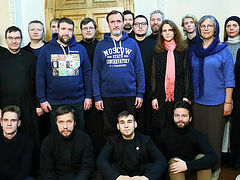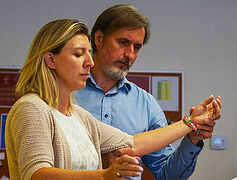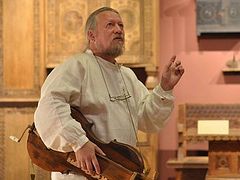Znamenny chant seems to many church people to be a parallel world. It is no wonder because in today’s Russian Orthodox Church it can seldom be heard. Meanwhile, it is an integral part of our church culture, which only at a superficial glance seems archaic. Alexei Alexeyevich Gvozdetsky, Associate Professor of the Department of Russian Folk Music of St. Petersburg State Institute of Culture (SPSIC), the choir director of St. Vladimir’s Choir of the village of Shcheglovo in the Leningrad region, artistic director of the Russian Choir of SPSIC and the Vervitsa ensemble of ancient Russian chant at the Department of Russian Folk Song of SPSIC, has talked about this living tradition.
—How did you come to Znamenny chant?
—I was the director of an ordinary polyphonic choir. I have a very long experience in this field. The last place where I was a choir director was the Church of the Kazan Icon of the Theotokos in the village of Vyritsa, where I worked for fourteen years. That was preceded by eleven years at St. Paul’s Cathedral in the town of Gatchina and a little at different churches…
In the 1990s, there were many audio cassettes of Hierodeacon German (Ryabtsev; of Valaam Monastery)’s recordings on sale in church shops. I was shocked—it was something unknown that I didn’t understand, but I felt that there was something great and very important in it. It was new to me. The fact is that the relations between ancient Russian chant and professional education, including choral music and conducting, are terrible. I graduated from Gnesin Russian Academy of Music, then from the Moscow Conservatory (the Department of Conducting). What did I, an alumnus of such wonderful educational institutions, know about Znamenny chant? Practically nothing. We were shown pictures with incomprehensible signs and given transcripts performed by academic choirs to listen to; almost always these transcripts sounded very heavy and unconvincing. I didn’t really enjoy listening to those recordings.
 Alexei Gvozdetsky, Associate Professor of the Department of Russian Folk Music at St. Petersburg State Institute of Culture When I saw that there was another culture—living, breathing and very real—I became interested, but nothing more. Much later, I took a greater interest in this. Why did I start learning hook notation? I came across the statement of Archpriest Boris Nikolaev that it is impossible to perform Znamenny chant properly from music. I thought: “It’s a piece of music. How can I not write it down with printed music?” In order to refute this statement I began to study Znamenny chant—and very quickly realized that Archpriest Boris Nikolaev was 100 percent right: This culture is absolutely different. But another thing helped me. As an academic I started teaching at the Department of Russian Folk Song at SPSIC. At our department everything is arranged in such a way that you cannot teach only your subject without being involved in everything else in the life of the team. And I quickly came across the traditional culture of singing, which had been totally unknown to me; music scholars are not taught it.
Alexei Gvozdetsky, Associate Professor of the Department of Russian Folk Music at St. Petersburg State Institute of Culture When I saw that there was another culture—living, breathing and very real—I became interested, but nothing more. Much later, I took a greater interest in this. Why did I start learning hook notation? I came across the statement of Archpriest Boris Nikolaev that it is impossible to perform Znamenny chant properly from music. I thought: “It’s a piece of music. How can I not write it down with printed music?” In order to refute this statement I began to study Znamenny chant—and very quickly realized that Archpriest Boris Nikolaev was 100 percent right: This culture is absolutely different. But another thing helped me. As an academic I started teaching at the Department of Russian Folk Song at SPSIC. At our department everything is arranged in such a way that you cannot teach only your subject without being involved in everything else in the life of the team. And I quickly came across the traditional culture of singing, which had been totally unknown to me; music scholars are not taught it.
Thanks to my colleagues at the department and the books, I was able to understand that the traditional culture of singing is neither a “subculture” nor a “pre-culture”—it’s like another planet, something that lives according to different laws. It’s not below or above academic professional art—it’s just absolutely different. If I hadn’t immersed myself in this culture of singing and in traditional culture in general, I think that Znamenny chant would have been incomprehensible to me to this day. After all, hooks are not music set down in another notation; this is a fundamentally different way of thinking.
I attended several classes at the Department of Ancient Russian Chant at the St. Petersburg State Conservatory. Then I met the Znamenny chant singers, who in the Russian Orthodox Church all more or less know each other, because there are very few of them. Thanks to online publications I got acquainted with practical material. So I gradually got immersed in this tradition.
—Why is it impossible to record Znamenny chant with music properly?
—The specifics of musical notation are that a musician without knowing the tradition can perform a work unknown to him with music; perhaps with some stylistic errors, but he can repeat a melody more or less accurately. Hooks are ideographic, or even hieroglyphic writing. It conveys an idea, an archetype. The reproduction of this idea will vary in different traditions. Only the main things are recorded in hooks, while many precious details that are a melodic characteristic of a particular tradition are transmitted orally. It is not a written culture, but an oral-written one, and the oral component dominates the written one. So hooks are a brilliant national language for recording chants so that you can simply recall what you already know.
This idea: “I’ll take a book, see how hooks are translated into music, and learn how to decipher melodies quickly”—reminds me of writing Russian texts in Latin letters, as on the first mobile phones in Russia without a Russian keyboard. It seems the meaning is clear, but it is absolutely unsatisfactory...
Our students have a subject, “Decoding Folk Songs”. They go on expeditions, wonderful old women sing them songs, and then they translate them into music from audio recordings. There is a very interesting pattern: the more accurate the musical notation, the less suitable it is for reproduction; and vice versa: the simpler the recording and the less it reflects what is recorded, the more suitable it is for reproduction. That is, a discrepancy between the nature of the noto-linear recording and the traditional culture of singing is obvious. Here the difference between traditional culture and modern culture is clearly seen. As Associate Professor of our department Elena Evgenyevna Vasilyeva says, in traditional culture a performer every time generates a text (in our case, a melodic one) based on the archetype that he mastered earlier.
—So you can really learn only by word of mouth?
—Of course, it is the best way. But if not by word of mouth (there are few such opportunities), then at least by recording; there are a huge number of them now.
—Are new chants being composed nowadays? After all, enthusiasts of Znamenny chant insist that it is a living tradition.
—Undoubtedly, the tradition is alive in the sense that it has never faded away completely, although the eighteenth and the nineteenth centuries were, to put it mildly, not the best time for this tradition. The death of tradition associated with historical, political and other factors is a sad reality. Nevertheless, new chants are being composed as well. The Znamenny chant singers who sing in churches of the Moscow Patriarchate sing new texts to Znamenny drones [similar to the ison in Byzantine chant]—for example, the service to St. Seraphim of Sarov.
But it should be understood what a chanter did and how he differed from a composer. The former did not compose new hymns; he took drones and distributed them throughout the text. Oddly enough, it is similar to what children do when they build with a Lego set. You have some ready-made parts; you won’t make new ones, but you will build something special, different from the existing ones. Although, perhaps this is a far-fetched comparison—drones are still very varied. The beginning, the end of a drone or a combination of one drone with another. Of course, there are elements of creativity here. Nevertheless, this is not a composition in the modern understanding of this process.
The composers of modern times illustrated and interpreted the texts. Joy on Pascha, and sadness on Holy Friday. There is no such thing in Znamenny chant, everything is sung there with the same drones. The fact is that church music of modern times is an emotional art that is within the framework of aesthetics. Nikolai Diletsky wrote in his treatise: “There is music which excites human hearts with its voice—either to joy or to sorrow.” To joy—that which is in a major, to sorrow—that which is in a minor.
In the Soviet Union, Orthodox hymns could be performed on stage only with new texts. For example, Balakirev wrote his work to the text, “From above the prophets foretold of Thee, O Maiden,” and academic choirs sang: “The evening twilight has fallen to the ground, the sunset has gone out in the haze...” and so on. Why was it possible? Because spiritual music of modern times, regardless of the text, bears a certain emotion, has a certain character. This music can be played on an instrument, it can be sung with a new text. Try to sing a Znamenny monody with such a text as I mentioned. It would be extremely absurd. As the great researcher of Russian Church musical culture Ivan Alexeyevich Gardner noted, the theatrical element in Church art of modern times is sizeable. Every good artist knows that in order to convey an emotion to the audience it needs to be exaggerated a little—that is, he should deceive listeners a little.
There is nothing like this in medieval church culture—not only in Russian, but also in Byzantine or Coptic. As a singer who sings with hook notation I hardly ever act as an interpreter: I just voice the text. It sounds very expressive, but surprisingly unemotional. These are emotions of an absolutely different order. Scholars write about the emphatic neutrality of this melos. There are no forte, piano, decelerations or accelerations; there are completely different possibilities of expression.
—There is an opinion that the very pace of modern life is such that it does not allow modern people to perceive ancient music properly, just as acceleration does not allow most people to wear vintage dresses. Can Znamenny chant be available to an average listener, or is it the lot of a few?
—Today it really looks like something very peripheral. Anatoly Grindenko once said that if you sing a piece by Tchaikovsky poorly in a church choir, no one will complain about Tchaikovsky—they will say that you sing badly. but if Znamenny chant is poorly performed, there will be no complaints about you—people will say that Znamenny chant is impossible to sing.
The matter is probably not in the pace of life, but in the worldview of modern people, in their sensitivity. In the Church we look for the same things that we look for outside the Church. And church music is precisely music. But the word combination “spiritual music” sounds like an oxymoron, because “music” is a humanistic concept, whereas spiritual practices are connected with asceticism. In my view, there is a combination of things that can’t be united in spiritual music. But this practice has been rooted in Russia for centuries. And the tradition spanning a generation and a half is very important in the Church; they say, “When I came to the Church as a young man, they sang like this—and it will be like this when I am seventy-five.” That is, these are attempts to preserve what we have, whatever it is.
I think the way out is the following: let the culture of Znamenny chant be understood only by those who ARE interested in it, enjoy it, need it for their inner spiritual realm and find it better to pray this way. There should be no prohibitions here. Prohibitions, as a rule, have an opposite effect, and it is a painful subject. If you open the periodical press and other documents of the second half of the nineteenth and the very beginning of the twentieth centuries, you will be surprised—bishops and priests mostly endorsed canonical singing, and laypeople, new music. Now, as a rule, the opposite is true: the clergy, with rare exceptions, are wary of Znamenny chant, and enthusiasts of Znamenny chant do not always find understanding.
When Znamenny chant is sung in church as an extra, it’s probably not bad. But this is another aspect of the modern eclecticism of church singing. In my view, Znamenny chant is only really good when it is a liturgical system, when it sounds, for example, throughout the Liturgy. Otherwise, not much changes. In addition, it is still very hard for the ancient chant to reach the proper level. And who sings with hook notation? I believe there are several hundred such people in Russia, if we talk about the members of the Moscow Patriarchate. I am not speaking about Edinoverie parishes—it is clear that they sing with hook notation there—I am talking specifically about parishes of the new rite.
To be continued…





